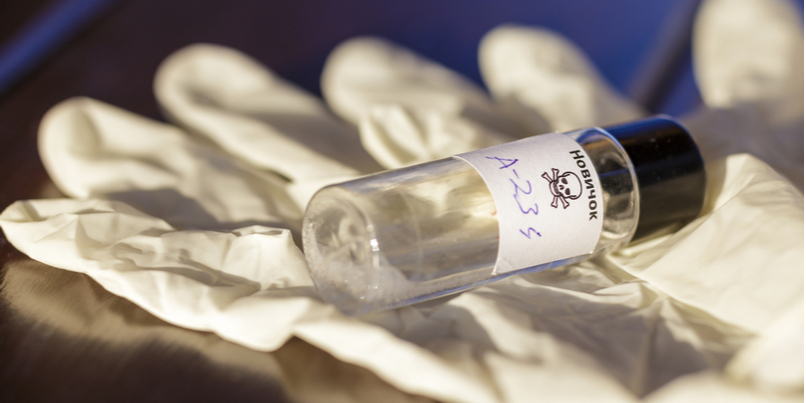 The disturbing events in Amesbury, UK in which two members of the general public were exposed to the nerve agent Novichok, have once again brought into sharp focus the silent yet deadly threat of chemical warfare agents.
The disturbing events in Amesbury, UK in which two members of the general public were exposed to the nerve agent Novichok, have once again brought into sharp focus the silent yet deadly threat of chemical warfare agents.
In this blog post we provide a summary of the key features of weaponized nerve agents, with a specific focus on the family of "fourth generation" chemical compounds that are jointly referred to as Novichoks.
The nature of nerve agents
Nerve agents are a group of highly toxic, environmentally persistent (and generally) organo-phosphorous compounds that affect nerve impulses in the nervous system.
They are so named because of the way their chemicals attack and disrupt the transfer of messages from nerves to organs. They specifically attack the body's autonomic (involuntary) processes which are responsible for respiratory rate, heart rate, digestion and salivation.
They are created in highly specialised laboratories and exist in a variety of forms, most commonly as liquids or as an ultra-fine powder. They are spread through a variety of methods including fogging or atomizing, smoke generation, explosions or aerosols.
The history of nerve agents
The earliest weaponized form of nerve agent is Tabun which was synthesized by a team of German scientists, led by Gerhard Schrader, on the eve of the Second World War. Its discovery was an accidental by-product of research into the use of insecticides.
The principal nerve agents are sarin (GB), soman (GD), tabun (GA) and VX.According to the US, the VX was the chemical used to kill the half-brother of Kim Jong-un in 2017.
Exposure to nerve agents
Nerve agents are easily absorbed via the respiratory tract. Victims can experience symptoms,such as runny nose and tightness in the chest or throat, within seconds or minutes after exposure.
In liquid form, nerve agents are readily absorbed via the skin and eyes. Vapours won't be absorbed through the skin unless in very high concentrations.Ocular effects can result due to both direct contact and systemic absorption.
The timing and nature of symptoms following dermal contact with a liquid agents depends upon the exposure dose. In some cases the effects may be delayed for up to 18 hours.
Ingestion is a relatively rare occurrence compared to skin contact or inhalation, however, they are readily absorbed through the gastrointestinal (GI) tract, with highly toxic effect.
Symptoms of nerve agent exposure
One of the first symptoms of nerve agent exposure is miosis - excessive constriction of the pupil of the eye.
Other major symptoms include convulsions, loss of consciousness, excessive fluid secretion of the lungs, high blood pressure, raised heart rate (and then later, lowered heart rate), nausea and vomiting.
Treatment
Treatment of patients exposed is a three-step process - comprising decontamination, followed by initial management of symptoms and then provision of an antidote.
Decontamination takes place by removing clothing, washing the body and flushing out the eyes with large amounts of water or saline solution.
The symptoms of poisoning can initially managed with with high doses of atropine - a compound derived from the belladonna plant (also known as deadly nightshade) which blocks acetylcholine receptors.
Atropine is administered intra-muscularly via an auto-injector. It works by slowing the action of the nerve agent, drying out secretions and increasing the patient's heart rate - but it is not in itself a cure.
Once symptoms have been managed, a nitrogen-containing chemical (known as an an oxime) can then administered. Oxime works by enabling the compromised cholinesterase enzyme to function again.
Within a battlefield context, there is little time to waste waiting for decontamination.
So soldiers are equipped with auto injectors - typically comprising a combination of atropine and pralixodome chloride - which can be immediately self-administered if exposure to a nerve agent is suspected.
In the event that a soldier is at the stage of actively convulsing, an anti-convulsant antidote such as diazepam needs to be administered by a third party.
Novichoks
The term Novichok refers to a family of fourth generation chemical weapons developed by the Soviet Union and Russia between 1971 and 1993. Their existence was unknown to the West until the early 1990s.
Novichoks were designed to be undetectable by standard NATO detection equipment and they fall outside of the definitions of other controlled substances under the Chemical Weapons Convention (CWC).Some variants of Novichok are believed to be up to eight times more toxic than the VX nerve agent.
Novichoks are classed as "binary weapons," due to the fact that they are often stored as two separate, less-toxic chemical ingredients which only become active when they are mixed.
Binary weapons are more problematic to detect because their component parts are not banned, meaning they are easier to store, handle and transport without arousing suspicion.
The use of nerve agents is a major concern across the globe to both military First Responders and citizens alike. As we have detailed, another worrisome consideration is the "fourth generation" novichoks which only become active when mixed. These binary weapons can be difficult to track and uncover, which makes proper CBRNe knowledge and training even more critical. Creating realistic simulations involving nerve agents is a key method to ensure responders are prepared, and simulators can make this training both effective and efficient. Learn more about using simulators for chemical warfare response training in our free guide.





